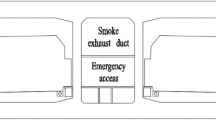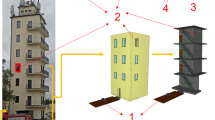Abstract
The window purifying ventilator is a relatively new idea that involves replacing one part of the window frame with a ventilator, for which the core component is a cross-flow fan (CFF). When a CFF is applied to the window purifying ventilator, a filter should be added, and its casing should be modified. In this paper, first, time-accurate solutions with a sliding mesh technique were developed for modelling the two-dimensional viscous and incompressible model of CFF. Three prevalent two-equation turbulence models (Standard, RNG and Realizable k–ε models) for CFF simulation were compared and validated in the experiments, and the most suitable model for this type CFF was found. Based on the time-accurate simulation, the formation of flow construction inside the CFF was also observed and explained. Next, the CFF was optimized for window purifying ventilator by redesigning and modifying the shape and location of vortex wall and rear wall, both numerically and experimentally. From the research results, the vortex wall’s position has a great influence on the ventilator’s performance by determining the position and intensity of eccentric vortex, and the shape of the rear wall also affects the ventilator’s performance by determining the flow pattern and internal flow resistance. Through appropriate designing the vortex and rear wall, finally, the CFF could apply to the window purifying ventilator with acceptable flow rates.
Similar content being viewed by others
References
Abt E, Suh HH, Catalano P, Koutrakis P (2000). Relative contribution of outdoor and indoor particle sources to indoor concentrations. Environmental Science & Technology, 34: 3579–3587.
Ansys (2013a). Ansys Fluent 15.0 User’s Guide. Ansys Inc.
Ansys (2013b). Ansys Fluent 15.0 Theory Guide. Ansys Inc.
Awbi HB (2003). Ventilation of Buildings. London: Taylor & Francis.
Bel-Hassan M, Sardar A, Ghias R (2008). CFD simulations of an automotive HVAC blower: Operating under stable and unstable flow conditions. SAE Technical Paper, No. 2008-01-0735.
Casarsa L, Giannattasio P (2011). Experimental study of the threedimensional flow field in cross-flow fans. Experimental Thermal and Fluid Science, 35: 948–959.
Chen C, Zhao B (2011). Review of relationship between indoor and outdoor particles: I/O ratio, infiltration factor and penetration factor. Atmospheric Environment, 45: 275–288.
Chernobrovkin AA, Lakshiminarayana B (1999). Numerical simulation of complex turbomachinery flows. NSA Technical Report, No. NASA/CR-1999-209303.
Eck B (1973). Fans: Design and Operation of Centrifugal, Axial-Flow, and Cross-Flow Fans. Oxford: Pergamon Press.
Govardhan M, Sampat DL (2005). Computational studies of flow through cross flow fans-effect of blade geometry. Journal of Thermal Science, 14: 220–229.
Klepeis NE, Nelson WC, Ott WR, Robinson JP, Tsang AM, Switzer P, Behar JV, Hern SC, Engelmann WH (2001). The National Human Activity Pattern Survey (NHAPS): A resource for assessing exposure to environmental pollutants. Journal of Exposure Analysis and Environmental Epidemiology, 11: 231–252.
Kopperud RJ, Ferro AR, Hildemann LM (2004). Outdoor versus indoor contributions to indoor particulate matter (PM) determined by mass balance methods. Journal of the Air & Waste Management Association, 54: 1188–1196.
Lazzaretto A (2003). A criterion to define cross-flow fan design parameters. Journal of Fluids Engineering, 125: 680–683.
Lazzaretto A, Toffolo A, Martegani AD (2003). A systematic experimental approach to cross-flow fan design. Journal of Fluids Engineering, 125: 684–693.
Lazzarotto L, Lazzaretto A, Martegani AD, Macor A (2001). On crossflow fan similarity: Effects of casing shape. Journal of Fluids Engineering, 123: 523–531.
Liu M, Wang J, Wu K (2007). Performance and noise prediction of variable pitch cross flow fans by numerical simulation. Journal of Engineering Thermophysics, 28: 211–214. (in Chinese)
Noël J-Y, Farall M, Casarsa L (2007). Aero-acoustics in a tangential blower: Validation of the CFD flow distribution using advanced PIV techniques. The International Journal of Multiphysics, 1: 377–392.
Shih YC, Hou HC, Chiang H (2004). Numerical study of the similarity law for the cross-flow fan of a split-type air conditioner. ASHRAE Transactions, 110(2): 378–388.
Sun K, Ouyang H, Tian J, Wu Y, Du Z (2015). Experimental and numerical investigations on the eccentric vortex of the cross flow fan. International Journal of Refrigeration, 50: 146–155.
Tanaka S, Murata S (1995). Scale effects in cross flow fans: 2nd report, effects of fan dimensions on flow details and the universal representation of performances. JSME International Journal Series B: Fluids and Thermal Engineering, 38: 388–397. (in Japanese)
Toffolo A (2005). On the theoretical link between design parameters and performance in cross-flow fans: A numerical and experimental study. Computers & Fluids, 34: 49–66.
Toffolo A, Lazzaretto A, Martegani AD (2004). An experimental investigation of the flow field pattern within the impeller of a cross-flow fan. Experimental Thermal and Fluid Science, 29: 53–64.
Tsurusaki H, Shimizu H, Tsujimoto Y, Yoshida Y, Kitagawa K (1996). Study of cross-flow-fan internal flow by flow visualization: 1st report, discussion of measured results by particle-tracking velocimetry. JSME International Journal Series B: Fluids and Thermal Engineering, 39: 540–545. (in Japanese)
Turpin BJ, Weisel CP, Morandi M, Colome S, Stock T, Eisenreich S, Buckley B (2007). Relationships of indoor, outdoor, and personal air (RIOPA): Part II. Analyses of concentrations of particulate matter species. In: Research Report (Health Effects Institute). Cambridge, USA: Health Effects Institute.
van Donkelaar A, Martin RV, Brauer M, Kahn R, Levy R, Verduzco C, Villeneuve PJ (2010). Global estimates of ambient fine particulate matter concentrations from satellite-based aerosol optical depth: Development and application. Environmental health Perspectives, 118: 847–855.
Versteeg HK, Malalasekera W (2007). An Introduction to Computational Fluid Dynamics: The Finite Volume Method, 2nd edn. Harlow, UK: Prentice Hall.
Yamafuji K (1975). Studies on the flow of cross-flow impellers: 1st report, experimental study. Bulletin of JSME, 18: 1018–1025.
Zhang MJ, Pomfret MJ, Wong CM (1996). Three-dimensional viscous flow simulation in a backswept centrifugal impeller at the design point. Computers & Fluids, 25: 497–507.
Author information
Authors and Affiliations
Corresponding author
Rights and permissions
About this article
Cite this article
Li, J., Hou, Y., Liu, J. et al. Window purifying ventilator using a cross-flow fan: Simulation and optimization. Build. Simul. 9, 481–488 (2016). https://doi.org/10.1007/s12273-016-0281-8
Received:
Revised:
Accepted:
Published:
Issue Date:
DOI: https://doi.org/10.1007/s12273-016-0281-8




